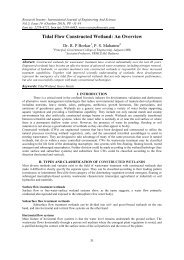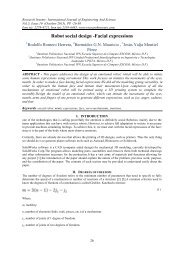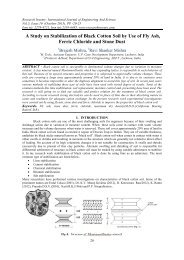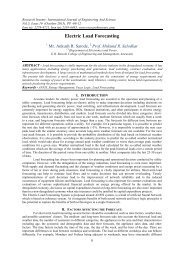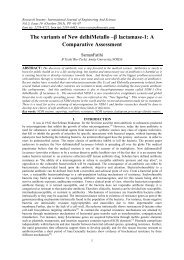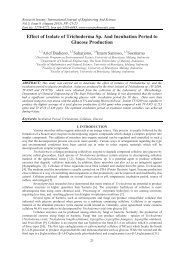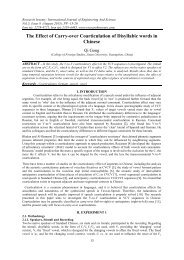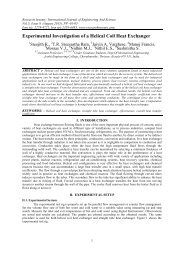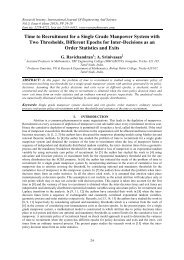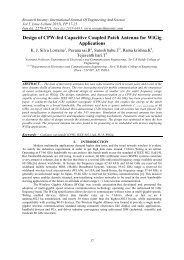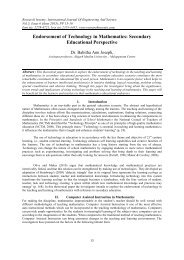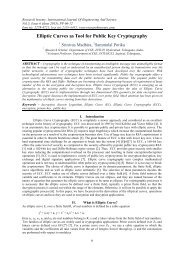o_19lj7p87a1n5b1sl7s74op81ahvj.pdf
Create successful ePaper yourself
Turn your PDF publications into a flip-book with our unique Google optimized e-Paper software.
Research Inventy: International Journal Of Engineering And Science<br />
Vol.5, Issue 4 (April 2015), PP 11-15<br />
Issn (e): 2278-4721, Issn (p):2319-6483, www.researchinventy.com<br />
Impact of International MOOCs on College English Teaching and<br />
Our Countermeasures: Challenge and Opportunity<br />
WEI Li<br />
(Liaoning Police Academy, Dalian, 116036, China)<br />
Abstract –MOOCs are world-wide online courses with the purpose of open visit and massive participation,<br />
which is the newly-booming course model in the global educational field. The article firstly introduces the<br />
outline of MOOCs in terms of types, theoretical foundations, features in course models and contents, and then<br />
analyzes the impacts of MOOCs on Chinese college English teaching including the quality of college English<br />
teaching, the contents of college English course, and the assessment system of college English test. In the latter<br />
part of the article, the author puts forward effective countermeasures to respond to this new educational<br />
situation. They involve the establishment of Flipped English Class under the MOOCs environment, and the<br />
adjustment of college English contents and curriculum system to apply MOOCs teaching resources into our<br />
English teaching research and English class.<br />
Keywords –Impact, MOOCs, College English teaching, Countermeasures, Challenge<br />
I. INTRODUCTION<br />
MOOCs (Massive Open Online Courses) is the educational pop term in 2012, attracting active<br />
participation from American prestigious universities. According to the network actual circumstances, three<br />
MOOCS websites of Udacity, Coursera and edX in America have established 600 courses by November 2013,<br />
and these courses cover many languages and include 30 subjects. At present, more than 100 famous educational<br />
institutions and millions of learners participate in MOOCs.<br />
The rapid and integrated development of MOOCs is bound to have radical impact on the society. Once<br />
the openness of high-quality higher education resources goes beyond campus, covering every corner at home<br />
and abroad, individuals, families, enterprises, and governmental agencies can enjoy perfect knowledge,<br />
inforrmation and skill training without limit. Undoubtedly, an actual learning society and knowledge society is<br />
approaching. [1] Under such educational situation, MOOCs will exert a great influence on college English. Data<br />
of 2013 indicates that the platform of Coursera provides 12 language courses, and 91% of them are lectured in<br />
English. Here, English acting as the main learning tool has become undisputable reality and college students can<br />
enhance their English levels through focusing on some knowledge points.<br />
College English as a single course with the highest proportion in college credits has always been the<br />
experimental field for teaching reform. Curriculum Requirements for College English Teaching issued in 2007<br />
formulated to implement College English Teaching Model based on computer and classroom which stimulates<br />
students to participate in language learning with multi sense organs and improve their learning efficiency by<br />
means of multi-model presentation. Ministry of Education established the specialized project for College<br />
English Teaching Reform guiding colleges to implement new teaching model based on computer and classroom<br />
with the purpose to advance the deep integration of information technology into college English teaching. The<br />
booming of MOOCs will give compelling impetus to the actual progress of college English teaching reform.<br />
II. THE OUTLINE OF MOOCS: THEORETICAL FOUNDATION, COURSE MODEL<br />
AND FEATURES<br />
2.1 The MOOCs types and their theoretical foundations<br />
MOOCs include two types, one is cMOOC, and the other is xMOOC. cMOOC is based on<br />
Connectivism learning theory. George Siemens, the founder of CCK08, holds that knowledge is connected by<br />
network, and learning is a process to connect specialized nodes and information sources. [2] cMOOC attaches<br />
much importance to the knowledge creation and generation, which connects instructors and learners together<br />
who are distributed over the world through a common topic and theme. Learners build learning network and<br />
construct knowledge by means of communication and cooperation. [3] xMOOC is based on Behaviorism<br />
learning theory whose core theory is Skinner’s operational conditioned response learning [4] which considers<br />
knowledge as some particular response combination, regarding that most of human learning is operational<br />
learning in which consolidation is the vital measure to form operational conditioned response and teaching is to<br />
arrange events to make consolidation in order to promote learning. There are three conditions to render learning<br />
efficient; they are: to present learning materials with minor stages and fewer contents, to offer timely feedbacks<br />
11
Impact of International MOOCs on College English Teaching and Our…<br />
to learners’ any response; to make learning process by learners themselves. According to different theoretical<br />
focuses, specialized course design, learning environment establishment, and learners’ behavioral management<br />
can be formulated scientifically and reasonably.<br />
2.2 The analysis of MOOCs features in course models and contents<br />
There are huge differences between cMOOC and xMOOC owing to different theoretical foundations.<br />
cMOOC belongs to knowledge construction type, focusing on knowledge construction and creation, and<br />
stressing creation, autonomy and social network learning. Figure 1 presents the concrete links of this theory. The<br />
course is distributed in different places of the network; teachers and students contribute their ideas to the course<br />
together; learners enjoy higher autonomy to connect and construct new knowledge through resources sharing<br />
and different cognition and multi-perspective interaction.<br />
Fig 1: The general course model of cMOOC (referenced from Wang Ping’s figure [3]<br />
However, the course model of XMOOC reflects the traditional teaching concept and process, paying<br />
more attention to learning contents, knowledge passing on and copying, and meanwhile, emphasizing such<br />
learning methods as videos, assignments and tests. Figure 2 reflects that instructors provide and organize<br />
contents, encouraging students to finish learning the course completely and linearly. As to most of xMOOCs,<br />
they not only involve videos teaching, but also a series of matched teaching methods and process, such as online<br />
tests, common sharing, multi-aspect interaction, peer review, and so on.<br />
Fig 2: The general course model of xMOOC (also referenced from Wang Ping’s figure [3])<br />
In practice, there are also some big differences between these two MOOCs. All cMOOCs belong to<br />
single courses organized and taught by instructors themselves without other educational institutions’<br />
participation. xMOOCs, on the other hand, are based on platform operation which cooperates with famous<br />
universities and commercial organizations operated in commercial form. Nowadays, three major MOOCs adopt<br />
xMOOC model whose influences are much greater than cMOOC.<br />
12
Impact of International MOOCs on College English Teaching and Our…<br />
Meanwhile, we can also conclude the following features that MOOCs possess include the time<br />
limitation (generally each course will last 2 to 12 weeks, and those who don’t register cannot visit the course<br />
when it is finished), the regular assignment with timely accomplishment and peer review, the active interaction<br />
among various participants, the learners’ learning file, the statement of accomplishment for finishing the course<br />
and obtaining certain credits. [5] Apart from them, there are three key specialties of MOOCs. They are micro<br />
videos, automatic assessment system, and learners’ interactive forum. [6]<br />
Coursera, as the most popular MOOCs platform today, has established nearly 600 courses by the end of<br />
2013 which concern 25 categories including art, biology, chemistry, education, social science, statistics, and<br />
teacher’s education. This platform provides 12 languages and 84.3 percent of them are lectured in English. That<br />
is to say, there are 486 English courses which cover 90 humanities courses, 68 social science courses, 67 health<br />
& society courses, and 63 biology and life sciences courses. This platform is really a superior course<br />
supermarket meeting the requirements of learners to choose various courses. The classification of each course is<br />
very concrete, for instance, Computer Science is classified into Artificial Intelligence, Software Engineering,<br />
Systems & Security, and Computer Theory. Therefore, learners have adequate space to choose their particular<br />
learning field, to choose An Introduction to Public Speaking if you like speech, and to choose English<br />
Composition I: Achieving Expertise if you want to improve English writing.<br />
III. MOOCS’ INFLUENCE ON CHINESE COLLEGE ENGLISH TEACHING:CHALLENGES [7]<br />
With the popularity of MOOCs, our college English teaching is confronted with serious challenges. On<br />
one hand, a great number of international non-language MOOCs (English as the teaching language) are<br />
uploaded to the platform, which equal to all-English specialized course set in some universities. On the other<br />
hand, English Council declares that it will cooperate with Future Learn to establish English Language MOOCs<br />
to help improve English levels. These courses are based on its abundant support and evaluation for global<br />
students and teachers. The first batch of courses is open to the world in 2014. These new English Language<br />
MOOCs can make global learners efficient in English communication and receive higher education in English.<br />
3.1 The challenge for the quality of college English teaching<br />
According to the recent survey, more and more Chinese netizens participate in MOOCs learning. 80<br />
percent of them are bachelor’s degree or above. But only a small percent (about 6 percent) of them finish<br />
learning the whole course. The elements preventing them from fulfilling the course mainly consist in limited<br />
time for MOOCs learning, lack of persistence, language barrier, and discrepancy between course contents and<br />
anticipations.<br />
MOOCs pose the challenge for the training quality of our higher education talents. Most of the college<br />
students after finishing college English course cannot meet the language requirements of MOOCs. Although the<br />
Curriculum Requirements of 2007 proposed to improve the students’ comprehensive competence in English, our<br />
college students cannot be equipped with adequate comprehensive skills in English. Moreover, MOOCs are<br />
student-centered courses, posing the direct challenge for Chinese teacher-centered English teaching model.<br />
MOOCs construct all-English learning environment, provide classical learning resources, and practice teacherto-student<br />
and student-to-student online interaction in order to enhance teaching quality and establish super<br />
English course.<br />
3.2 The challenge for the contents of college English course<br />
Generally, MOOCs are composed of four links; they are micro-videos, designated reading references,<br />
forum discussion, and assignments. Language barrier is the vital element to stop students’ learning MOOCs, and<br />
it can happen in any link. Maybe learners cannot understand videos and reading materials, or they cannot finish<br />
their homework.<br />
College English teaching materials are made up by integrated college English and visual-audio-oral<br />
course which stress the importance of improving humanity attainment, but neglect the individual learning<br />
requirements inclusive of academic English training. Therefore, learners’ follow-up development in English is<br />
affected. MOOCs are quite different from our curriculum installation. On the platform of Coursera, there have<br />
been 486 English courses covering many majors. What’s more, MOOCs have free and non-credit courses which<br />
pose challenges for those dull, boring and authoritative credit courses.<br />
3.3 The challenge for the assessment system of college English test<br />
Chinese Curriculum Requirements of 2007 proposed that there should be two assessment methods, one<br />
is formative assessment, and the other is summative assessment. But, in fact, the quality of formative assessment<br />
is not as high as expected owing to the fact that college English is only regarded as public elementary course,<br />
and English teachers have to teach the big class with so many students. The summative assessment tends to<br />
weigh the passing rate of all the students of the grade. In addition, the main standard that employers judge the<br />
students’ English proficiency is performance in CET 4 and 6. The students have to spend plenty of time on<br />
13
Impact of International MOOCs on College English Teaching and Our…<br />
preparing for these tests, memorizing vocabulary mechanically, repeating the exercises of reading<br />
comprehensions, and practicing standard listening with standard speed and test model. Once these students<br />
appear in the real context, they cannot respond to this actual scenario. Furthermore, they are unable to adapt to<br />
MOOCs with various speed and teaching styles from famous lectures. Due to deficiency of finance, material<br />
resources and manpower, massive oral test cannot be implemented effectively, and, as a result, the training in<br />
speaking and listening seems like an armchair strategy.<br />
IV.<br />
MOOCS’ INFLUENCE ON CHINESE COLLEGE ENGLISH TEACHING:<br />
COUNTERMEASURES<br />
4.1 The establishment of Flipped English Class under MOOCs environment<br />
At first, English teachers should change their teaching concept and improve English teaching<br />
technology attainment, realizing that they are not the authoritative knowledge source. English teachers can no<br />
longer take language points explanation as teaching focus, but make preparatory teaching ware to inspire<br />
students to finish self-study before English class. In each English class, teachers become guide, organizer, and<br />
supervisor; students become role-players, debaters, and most of important of all, the creators. Linguistic<br />
competence cannot be equal to memorizing competence and practical skills; it should be the competence<br />
combination of creative thinking, cooperative operating, and critical thinking.<br />
The start of education accompanied with knowledge, and when the knowledge is updated, education<br />
has to be adapted in good time. College English teachers should admit their deficiencies, complementing their<br />
outdated knowledge via logging in Coursera and learning the course of English Composition I: Achieving<br />
Expertise with their students together. This equal teaching attitude is the real reflection of the change of teaching<br />
concept. We permit and encourage our students to doubt and challenge our opinions and practice, which is the<br />
embodiment of educational democracy and common proving. In this information era, there is no knowledge<br />
authority. How to apply information technology to obtain knowledge and relevant information and how to rely<br />
on task-driven approach to propel students to throw into English learning and practicing have been the priorities<br />
of college English teaching reform.<br />
Secondly, English teachers should change their functions from directive teaching to constructive<br />
learning service. Flipped English Class is a class to construct deep-leveled knowledge, students being as the<br />
leading actors in it. This class highlights the combination of face-to-face learning and online learning, which<br />
requires the students pre-study teaching materials online in advance, and put forward questions and carry out<br />
discussions in English class. This teaching model can optimize the valuable teaching resources (that is the<br />
“time”), to help the poor students to develop learning motivation and narrow differences in leaning progress.<br />
4.2 The adjustment of College English teaching contents and curriculum system<br />
The biggest advantage of MOOCs is to make the famous course made by eminent teachers from<br />
prestigious universities open to the whole world freely, and the learners can set their own MOOCs learning<br />
process all by themselves. Those college students with spare capacity can learn MOOCs to participate in global<br />
network discussion on curriculum contents and exchanging learning experience.<br />
In order to solve the problem of language barrier preventing smooth MOOCs learning, on one hand,<br />
we should answer the questions in our English class to help students seek the answers in the process of MOOCs<br />
learning. On the other hand, we should make a survey to find the concrete language barrier in their learning,<br />
strengthening those language points in class teaching process. Furthermore, English teachers can offer some<br />
assessments for students’ homework in writing or other subjects to replace the regular peer review.<br />
In recent years, the voices of reforming college English teaching contents are very strong and diverse;<br />
some experts argue that teaching contents should be ESP and EAP, while others believe that the contents should<br />
be general knowledge to develop student’s humanities quality and cross-cultural competence. Different voices<br />
are attributable to different circumstances of their universities. It is necessary to establish the combined college<br />
English curriculum system of EGP plus ESP. Meanwhile, teachers can conduct survey on MOOCs learning<br />
among their college students and adjust English curriculum system in accordance with students’ learning<br />
requirements.<br />
V. CONCLUSIONS AND REFLECTIONS<br />
The development of language is rooted in social development; to keep pace with the times is the<br />
sensitivity that the language teachers should possess. To keep pace with the social development indicates the<br />
reforming of outdated teaching methods. [8] MOOCs, as the brand-new online teaching model, pose great<br />
challenges and valuable opportunities to our college English teaching and learning. MOOCs are not to<br />
revolutionize the higher education, but to advance the popularity of high-quality teaching resources, educational<br />
cost, educational quality and equality. MOOCs will complement and better, but not replace, the higher education<br />
institution. To establish Flipped English Class under MOOCs environment and to reconstruct college English<br />
14
Impact of International MOOCs on College English Teaching and Our…<br />
teaching system fully reflect the deep integration of educational information technology into foreign language<br />
curriculum in MOOCs era. On reconstructing college English curriculum system, we should remember that<br />
MOOCs themselves are massive superior teaching resources and we can introduce them to our teaching practice,<br />
enhancing our college English teaching qualities efficiently and rapidly.<br />
ACKNOWLEDGEMENTS<br />
The research is financed by College Teaching Reform Research Project of Liaoning Province (2014) No.<br />
UPRP20140574: Multi Models to Develop College Students’ 3C Abilities through Network College English<br />
Teaching and Learning Based upon Questions, and by the Foreign Language Reform Project of Liaoning Higher<br />
Education Academy of Liaoning Province (2014) No. WYYB014167: A Study of Policing English Modular<br />
Teaching Based on CBI Concept. And it is also financed by The Twelfth Five-year Plan for Educational Science<br />
project of Liaoning Province (2013) No. JG13EB053: On the Operation Mechanism of ESP Teachers’ Online<br />
Learning Community.<br />
REFERENCES<br />
[1] Su Fan, Luo Yan, Technological Myth or Educational Revolution: Impact of MOOCs on Higher Learning Education, Tsinghua<br />
Journal of Education, 4, 2013, 6-12.<br />
[2] Siemens, G. Connectivism: A Learning Theory for the Digital Age, International Journal of Instructional Technology and Distance<br />
Learning, 2, 2005, 1.<br />
[3] Wang Ping, New Development and Application of Massive Online Open Courses: from cMOOC to xMOOC, Modern Distance<br />
Education Research, 3, 2013, 15-21.<br />
[4] Skinner, B. F. The Science of Leaning and the Art of Teaching, Harvard Educational Review, 24, 1954.<br />
[5] Ma Wulin, Zhang Xiaopeng, On the Impact of MOOCs on College English Curriculum Setting, Computer-Assisted Education<br />
Research, 1, 2014, 87-88.<br />
[6] Jeffrey R. Young, Beyond the MOOC Hype: A Guide to Higher Education’s High-Tech Disruption, Kindle version, 2013, 192.<br />
[7] Ma Wulin, Hu Jiasheng, On the Impact of International MOOCs and Redesign of College English Curriculum, Computer-assisted<br />
Foreign Language Education, 3, 2014, 48-54.<br />
[8] Cheng Yunyan, Facing the Challenge and Flipping Ourselves: Opportunities and Challenges Faced by Foreign Language Teachers<br />
under the New Paradigm of Education, Computer-assisted Foreign Language Education, 3, 2014, 44-47.<br />
15



